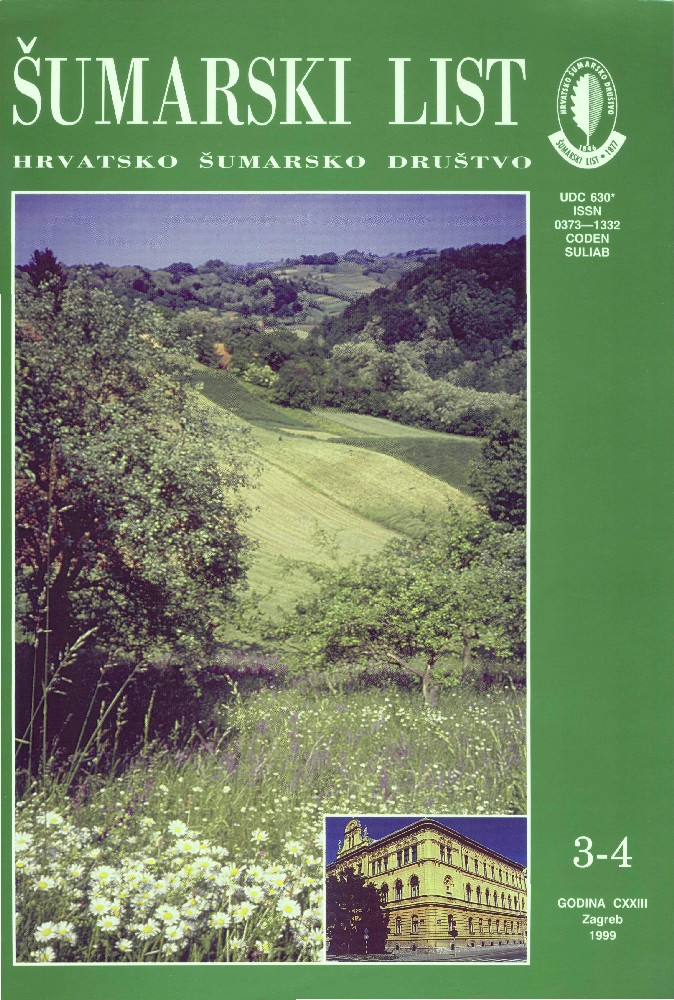
broj: 3-4/1999
pdf (20,2 MB) |
|
||||||||||||||
| IZVORNI ZNANSTVENI ČLANCI | ||
| Pleše, N., Juretić, N. | UDK 630* 444 (001) | |
| Virus Disease of Field Elm (Ulmus minor Mill.) in Croatia pdf HR EN | 95 | |
| Pernar, N., Bakšić, D., Španjol, Ž. | UDK 630* 114.2 + 235 (001) | |
| Some Characteristics of Humization in Pine Plantations on the Island of Rab pdf HR EN | 101 | |
| Kovačević, M. | UDK 630* 231 + 434 (001) | |
| Natural Regeneration of Wood and Macchia on the Burned Surfaces in Arboretum Trsteno pdf HR EN | 109 | |
| Summary: The aim of this research on the natural regeneration of vegetation on the burned surfaces in Arboretum Trsteno of Croatian Academy of Science and Art was to recognise the trand and stage of succesion in the course of reforestation seven years after the fire.In Arboretum macchia is present only as a fragment. The research carried out on the basis of twoo vegetational records, included 42 species. A certain number of heliophil species which have moved in from the rock grasslands are registrated in the records and are notable in the biological spectrum. Next to predominant Phanerophytes (26,8%), the Therophytes (23,2%) and Hemicryptophytes (13,7%) are significantly outstanding. It is noteworthy that Euphorbia dendroides, due to the opening of the vegetational cover caused by fire, has moved in by seeds from the near stand. The wood of alleppo pine has been developed on the bases of macchia as facies of the subassociation Orno-Quercetum ilicis myrtetosum. Terrains which are overgrown with woods today were mainly cultivated and abandoned 80 years ago, though many remains of old trees of Olea and Ceratonia can be found still today. In 6 vegetational records 51 species are included with predominance of Phanerophytes (60,8%) while Chamaephytes (17,75) and Hemicryptophytes (13,7%) take a bigger share in biological spectrum. The vegetational cover of the burned surfaces which have been researched is regenerating by sprouting from the underground organs of burned plants and by the seeds of plants from the same and surrounding localities. The proportion of the number of species which regenerate by sprouting and spreading by seeds is significant and amounts 1:2,5 for macchia and 1:1 for wood formation. Due to rather fast regeneration by sprouting from the roots the bush layer soon becomes dense and homogenuous and heliophil herbs decrease continually because of the increasing shade. Pinus halepensis regenerates due to natural reproduction by seeds like spontaneous species and on the burned surface its abundant offspring reaches the hight of about 2 m. The comparison between average number of species per record for burned wood stand in Arboretum (27,5 species) and for similar unburned stand on Šipan (25 species) shows unsignificant difference. As the result of research final conclusion should be that fire hasn´t caused the significant change (neither qualitative nor quantitative) in essential floristic composition of researched alleppo pine wood and macchia stands. The course of succession, seven years after the fire tends to anew toward the same association as it was before the fire. Such an early stage of alleppo pine wood is dense and absolutely impassable and therefore highly endangered with fire, especially if burned and overthrown trees are not removed. Rotten trunks are also favourable substrate for progressive development of secondary ksilophagus parasite population which represent a threat of later damage on vegetation. Renewal of vegetation in Arboretum which is in the course of its natural regeneration has to be supported by clearing terrains of burned and rotten trees and by protection from graizing and pasturing. Further maintenance of this part of Arboretum has to be carried out through protection of natural surfaces on the bases of nature reserve, which absolutely corresponds to strategy of managing with object protected by the Legislature on the Protection of Nature. | ||
| PRETHODNO PRIOPĆENJE | ||
| Grubešić, M., Dorotić, I. | UDK 630* 156 + 41.423 : 116 | |
| The Impact of Flood on Game and Hunting pdf HR EN | 119 | |
| PREGLEDNI ČLANCI | ||
| Harapin, M. | UDK 630* 453 | |
| The horse-chestnut miner (cameraria ohridella Deschka & Dimić) a dangerous pest in Europe pdf HR EN | 129 | |
| STRUČNI ČLANCI | ||
| Knepr, J. | UDK 630* 241 + 362 | |
| Simultaneous Research on the Performance of Motor Trimmers and Chain Saws pdf HR EN | 133 | |


